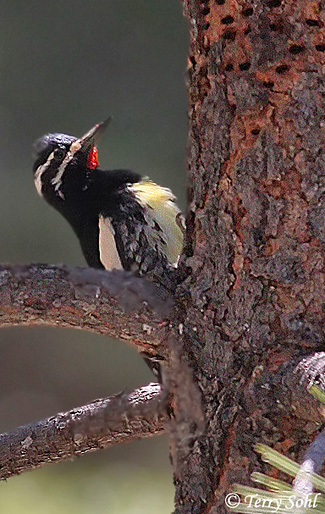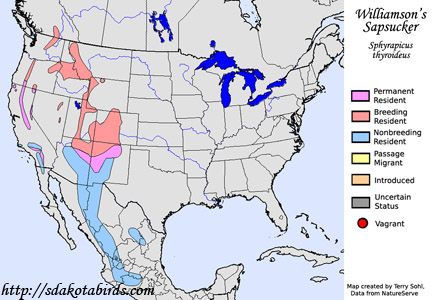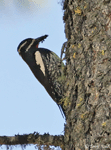| Length: 9 inches | Wingspan: 17 inches | Seasonality: Very rare visitor |
| ID Keys: Male black with white wing patch and rump, yellow belly, and thin white facial stripes. | ||
 Williamson's
Sapsuckers are generally found in the mountains of the western United
States, and are only extremely rare visitors to South Dakota. The male
and female of the species have strikingly different plumages, so much so
that they were once thought to be different species. As with other
sapsucker species, they drill "wells" in trees, feeding both on the sap that
seeps out, and the insects attracted to the sap. The photo to the right
depicts a Williamson's Sapsucker on a pine tree with sapsucker wells shown at
the top of the photo.
Williamson's
Sapsuckers are generally found in the mountains of the western United
States, and are only extremely rare visitors to South Dakota. The male
and female of the species have strikingly different plumages, so much so
that they were once thought to be different species. As with other
sapsucker species, they drill "wells" in trees, feeding both on the sap that
seeps out, and the insects attracted to the sap. The photo to the right
depicts a Williamson's Sapsucker on a pine tree with sapsucker wells shown at
the top of the photo.
Habitat: Found in mountainous conifer forests during the summer breeding season. Winters in lower-elevation pine and pine/oak forests.
Diet: Eats many insects and tree sap, and also feeds on fruits and berries.
Behavior: Drills typical sapsucker wells, taking both sap and trapped insects from the wells. Will also climb through foliage and branches in search of insects, fruits, and berries, hop along the ground in search of insects (especially ants), or occasionally fly out from a perch to catch passing insects in mid-air.
Breeding: Non-breeder in South Dakota.
Song: Usually silent, although they have a loud harsh screech similar to that of a Red-tailed Hawk's.
Migration: Summers throughout the mountains of the western United States. Most move southward along the Rockies for the winter, going as far as west-central Mexico. Some are semi-permanent residents, only moving to lower elevations in the winter.
Interactive eBird Map: Click here to access an interactive eBird map of Williamson's Sapsucker sightings
Similar Species: Yellow-bellied Sapsucker, Red-naped Sapsucker
Bird Feeders: Will attend feeders for suet, also nectar and sugar water.
Conservation Status: Numbers generally stable, they are found over a broad geographic area, and they are relatively common in parts of that range. The IUCN considers the William's Sapsucker to be a species of "least concern".
Further Information: 1) USGS Patuxent Bird Identification InfoCenter, Williamson's Sapsucker
2) WhatBird - Williamson's Sapsucker
3) Audubon Field Guide - Williamson's Sapsucker
Photo Information: June 18th, 2008 - Eastern Cascade Mountains of Oregon - Terry Sohl
| Click on the map below for a higher-resolution view |
 |
| South Dakota Status: The SDOU's "Birds of South Dakota" (2001) shows only one recorded instance of the species in the state, in Hughes County in 1975. |
Additional Williamson's Sapsucker Photos
Click for a higher-resolution version of these photos


